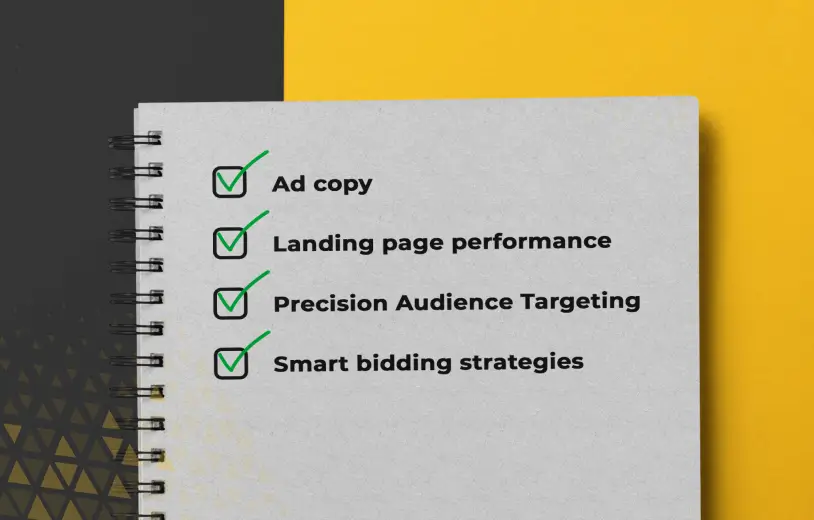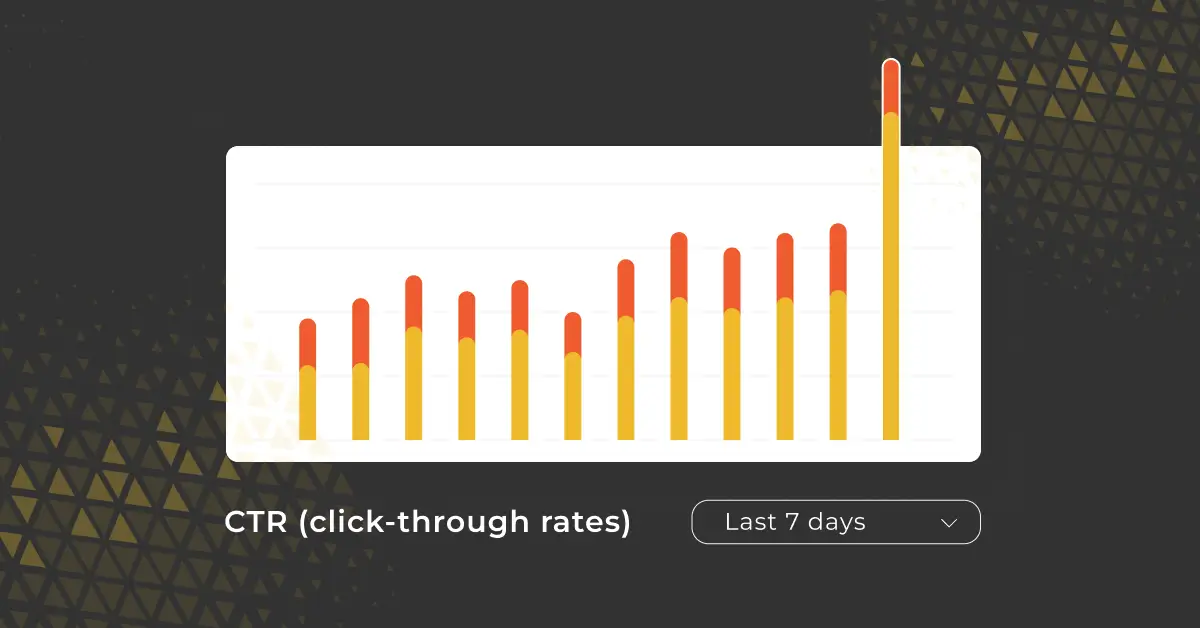Key Takeaways
- Set SMART Goals – Define Specific, Measurable, Achievable, Relevant, and Time-bound objectives for campaign success.
- Focus on Key Metrics – Track Quality Score, CTR, CPA, Conversion Rate, and ROAS to measure performance and profitability.
- Leverage A/B Testing – Test ad copy, landing pages, and targeting to refine performance and uncover what works best.
- Utilize Data Insights – Analyze historical trends, audience behavior, and seasonal patterns to optimize ad spend.
- Optimize Landing Pages – Improve design, messaging, and user experience to drive higher conversions.
- Integrate Advanced Tools – Use Google Analytics, Google Tag Manager, and CRM platforms for better tracking and insights.
- Target Precisely – Segment audiences based on demographics, interests, and behaviors to maximize ROI.
- Budget Smarter – Prioritize remarketing, high-intent audiences, and seasonal adjustments for better efficiency.
- Refine Continuously – Monitor key metrics and adjust campaigns based on real-time data to stay competitive.
- Think Long-Term – Sustainable PPC success comes from constant testing, tracking, and optimization.
Would you like to know the real power behind data-driven PPC campaigns?
Small eCommerce businesses are turning $500 PPC investments into $2,000 in sales. That’s a 300% ROI that proves the value of strategic digital advertising.
Success with PPC demands more than launching ads and crossing fingers. Savvy marketers know that data sits at the heart of every high-performing campaign. This methodical approach helps you pinpoint ideal audiences, optimize budget allocation, and measure true campaign impact.
Your PPC campaign success relies on four essential metrics:
- Cost Per Acquisition (CPA) – The actual cost to acquire a customer. Lowering CPA while maintaining quality leads is key to profitability.
- Conversion Rate (CVR) – Measures how effectively clicks turn into valuable actions, such as purchases or sign-ups.
- Return on Ad Spend (ROAS) – Evaluates how much revenue you generate for every dollar spent, making it a critical KPI for eCommerce and sales-driven businesses.
- Quality Score & Ad Relevance – Ensures that you receive the best possible CPC for high-intent traffic, influencing both ad placement and cost.
- Customer Lifetime Value (CLV) – Helps justify higher CPC if long-term value outweighs upfront costs.
These metrics create the foundation for ROI-focused decisions that drive real business growth.
Are you ready to unlock the full potential of your PPC campaigns? Let’s explore proven PPC marketing services that turn casual clicks into valuable conversions through data-backed decision-making.

Building a Data-Driven PPC Strategy
SMART goals shape the bedrock of successful PPC campaigns.
Your objectives must follow Specific, Measurable, Achievable, Relevant, and Time-bound principles to drive meaningful results.
PPC success hinges on 4 KPIs:
- Quality Score – Determines how relevant your ads, keywords, and landing pages are to user intent. A higher Quality Score can lower your cost per click (CPC) and improve ad placement.
- Click-Through Rate (CTR) – Measures how often users click on your ad compared to how often it appears. A higher CTR indicates stronger audience engagement and better ad relevance.
- Return on Ad Spend (ROAS) – Evaluates how much revenue your ads generate for every dollar spent. A higher ROAS means your campaign is driving profitable returns relative to your ad costs.
- Conversion Rate (CVR) – Tracks how effectively clicks turn into valuable actions, such as purchases, sign-ups, or leads. A strong conversion rate signals that your landing page and offer align well with user expectations.
Savvy marketers dig deeper than surface-level metrics. They research their market, analyze competitors, and use historical data patterns to reveal hidden opportunities and emerging trends. Modern PPC dashboards allow quick performance checks and strategic adjustments that boost campaign results.
Ad Quality Score
Google uses Ad Quality Score to help advertisers understand how their ads, keywords, and landing pages align with user expectations. A high Quality Score often correlates with better ad performance, but it does not guarantee premium ad positions or lower costs on its own.
Instead, Quality Score provides insight into three core factors:
- Ad Relevance – How closely your ad matches search intent.
- Expected Click-Through Rate (CTR) – Google’s prediction of how likely users are to click your ad.
- Landing Page Experience – The quality and relevance of your landing page to the ad and user query.
Testing for the Best Results
Then, strategic A/B testing uncovers the best combinations of ad elements, landing page designs, and audience targeting parameters.
This scientific approach to campaign optimization yields stronger performance metrics and better ROI over time. It allows you to make informed decisions, instead of running guesswork on what might stick.

Leveraging PPC Analytics for Decision-Making
Smart PPC decisions stem from expert-level data interpretation and analytical skills. Your campaign success depends on mastering key performance metrics and extracting insights you can use.
Looking at the Big Picture
Integrating data across digital platforms provides a comprehensive view of your campaign’s performance. Modern PPC tools enable real-time data synchronization, allowing advertisers to quickly shift budgets in response to market conditions. However, effective budget allocation goes beyond simply adjusting spend—it requires a strategic approach to maximize ROI.
These strategies can effectively prioritize your PPC budget for optimal performance:
- Branded vs. Competitor Targeting – Allocate a portion of your budget to branded keywords for cost-efficient conversions, while maintaining competitive bids for high-value competitor terms.
- High-Intent vs. Discovery Audiences – Prioritize spend on audiences with proven purchase intent (e.g., remarketing and in-market segments) while allocating a smaller test budget for discovery campaigns.
- Seasonal Budget Shifts – Adjust budgets based on historical conversion trends, increasing spend during peak sales periods and scaling back during low-demand seasons.
- Remarketing & Retargeting – Set budget aside for users who have already engaged with your brand, ensuring you stay top-of-mind for those most likely to convert.
By structuring PPC budgets around intent and opportunity, advertisers can maximize returns while maintaining agility.
Four key metrics guide strategic PPC decisions:
- Budget use vs daily allocation targets
- CTR and conversion rate fluctuations
- Campaign performance tested against your goals
- Market position through auction insights
Leveraging Historical Data
Historical data patterns show seasonal trends that can shape budget planning. This knowledge empowers you to channel resources into profitable regions while scaling back poorly-performing ones.
Predicting Future Trends
Understanding historical data also allows you to forecast future trends, which should be based on three core factors:
- Past performance patterns
- Seasonal variations
- Recent spending adjustments
This strategic approach safeguards against budget waste while maximizing campaign reach.
Knowing What Your Audience is Doing
PPC data uncovers important audience insights and market shifts. Demographic details – age, gender, location, and online behaviors – enable precise audience targeting.
Turning Data into Action
PPC success demands turning raw data into revenue-generating strategies. Your optimization roadmap should focus on four essential components:
- Ad copy – Craft magnetic headlines and action-driving CTAs
- Landing page performance – Design smooth user journeys
- Precision Audience Targeting – Fine-tune targeting using performance signals
- Smart bidding strategies – Balance spend and returns for peak ROI
A/B Testing Makes Informed Adjustments
Sharp campaign monitoring detects market shifts and evolving audience preferences. PPC experts rely on A/B testing to refine campaign elements, but valid testing goes beyond simple comparisons—it requires a data-driven approach to ensure accurate results.
To conduct meaningful A/B tests, consider these key factors:
- Sample Size – Ensure you have a large enough audience to draw reliable conclusions. Too few impressions or conversions can lead to misleading results.
- Statistical Significance – Use built-in platform testing features like Google Ads Experiments or Meta A/B Testing to determine if performance differences are meaningful or just random fluctuations.
- Conversion Rate Impact – Focus on metrics that directly influence your bottom line, such as CPA, ROAS, or conversion rate, rather than vanity metrics like CTR.
- Actionable Insights – Base tests on clear hypotheses (e.g., “Will a benefit-driven CTA increase conversions?”) rather than random changes.
- Focus your tests: Try not to test multiple elements at once, since you can’t be sure which elements improved results. Test one variation at a time to ensure you gather accurate information about what works.
By ensuring data validity, A/B testing becomes a powerful optimization tool—eliminating guesswork and refining your PPC strategy for sustainable success.
Leverage Advanced Tracking Tools
Accurate data is the foundation of successful PPC campaigns. Integrating Google Analytics, Google Tag Manager (GTM), and a CRM creates a seamless tracking ecosystem, allowing you to map the full customer journey from ad click to final conversion.
Here’s how these tools work together to improve tracking and decision-making:
Google Analytics (GA4) – Cross-Channel Data Visibility
- Captures detailed user behavior, showing how visitors interact with landing pages.
- Enables event tracking for actions like form submissions, purchases, and scroll depth.
- Provides insights into multi-touch attribution, helping you understand which marketing efforts drive conversions.
Google Tag Manager (GTM) – Simplifies Tracking Implementation
- Allows custom tracking setup without modifying website code directly.
- Facilitates event-based tracking, such as button clicks and video interactions, which can feed into both Google Analytics and your CRM.
- Helps implement conversion tracking pixels (Google Ads, Meta, LinkedIn, etc.) efficiently.
CRM Integration (e.g., HubSpot, Salesforce, Zoho) – Closing the Data Loop
- Connects PPC campaigns to actual revenue data, rather than just tracking clicks or leads.
- Enables lead scoring, so marketing teams can prioritize high-intent leads and optimize ad spend accordingly.
- Tracks customer lifetime value (CLV), helping justify higher bids for more valuable customers.
- Allows for remarketing automation, syncing customer data with ad platforms to serve ads based on past interactions.
By combining Google Analytics, Google Tag Manager, and CRM data, you move beyond surface-level PPC metrics and gain a deeper understanding of campaign effectiveness. Instead of optimizing for clicks, you can optimize for profitability and long-term customer value—ensuring your budget is spent on the audiences most likely to drive meaningful business growth.
Segmenting Your Audience
Effective audience segmentation is the backbone of a high-performing PPC strategy. Rather than using broad targeting, segmenting based on behavior and value allows you to focus your budget on the highest-converting users.
Key segmentation tactics for PPC success include:
- RFM Segmentation (Recency, Frequency, Monetary Value)
- Recency: Prioritize recent website visitors or buyers, as they are more likely to convert again.
- Frequency: Target users who engage with your brand often but haven’t converted yet.
- Monetary Value: Retarget high-spending customers with personalized offers or loyalty incentives.
- Behavioral Retargeting
- Cart Abandoners: Serve ads with limited-time offers or reminders to encourage checkout completion.
- Product Viewers: Target users who viewed a product but didn’t add it to their cart, using dynamic product ads.
- Engaged Non-Converters: Retarget visitors who spent time on key pages (pricing, testimonials) but left without converting.
- Lookalike & Similar Audiences
- Use high-value customer data to create lookalike audiences in Google Ads and Meta, expanding your reach to users with similar characteristics.
- Lifecycle-Based Targeting
- Cold Prospects: Introduce them to your brand with educational content and awareness campaigns.
- Warm Leads: Push product-focused messaging with social proof.
- Repeat Customers: Retarget past buyers with upsell and cross-sell offers.
By combining RFM segmentation, behavioral retargeting, and lifecycle-based targeting, you maximize ROAS and ensure that your PPC budget is directed toward the most valuable and engaged users—rather than wasting spend on low-intent audiences.
Optimize Your Landing Pages
Landing page optimization is one of the most impactful ways to improve PPC performance. Instead of making minor tweaks, focus on high-impact changes backed by data.
Key Landing Page Elements That Drive Conversions
- Compelling Headlines & Subheadings
- Your headline should immediately communicate value and match the intent of the ad.
- Use subheadings to reinforce key benefits and keep users engaged.
- Clear & Actionable CTAs (Call-to-Action)
- Place CTAs above the fold and repeat them strategically throughout the page.
- Use contrasting colors to make CTAs stand out.
- Keep CTA text action-driven, for example, “Get My Free Quote” instead of “Submit”.
- Form Optimization
- Shorter forms increase conversion rates; ask for only essential information.
- Multi-step forms break long forms into smaller steps, reducing friction.
- Autofill & validation improve the user experience.
- Social Proof & Trust Signals
- Include customer reviews, testimonials, and case studies to build credibility.
- Display trust badges (e.g., security seals, certifications) near the CTA.
- Use real customer photos instead of stock images.
- Fast Load Times & Mobile Responsiveness
- A 1-second delay can cause a 7% drop in conversions—optimize page speed.
- Ensure the page loads seamlessly on mobile and avoids intrusive pop-ups.
- Visual Hierarchy & Readability
- Use short paragraphs, bullet points, and bolded text to improve scannability.
- Images and videos should enhance the message, not distract from the CTA.
- Keep the layout clean with plenty of white space.
- Personalization & Dynamic Content
- Use location-based content to make offers feel relevant.
- Show dynamic product recommendations based on user behavior.
- Align copy with the ad’s messaging to maintain consistency.
Test & Optimize Continuously
Persistent A/B testing on CTAs, headlines, form length, and page layout uncovers what works best for your audience. Data-driven updates ensure that your landing page turns more visitors into paying customers.
Master Your PPC Campaigns
If you want to build winning PPC campaigns, focus on these three pillars:
- Clear SMART goals that guide your strategy
- Robust tracking systems that capture every insight
- Systematic A/B testing that refines performance
Smart PPC analysis uncovers powerful insights about your audience and market position. These insights shape intelligent budget decisions and targeting strategies, securing your competitive edge in crowded markets.
Are you ready to unlock your campaign’s full potential?
Talk to Fahrenheit Marketing’s specialists today. Our data-driven approach turns advertising investments into consistent wins.
FAQs
How do I structure an effective PPC campaign?
To build a good PPC campaign, make separate campaigns for brand keywords. Focus on one network for each campaign. Also, match your structure with your goals. Craft compelling headlines, descriptions, and display paths, and ensure your final URL is relevant to the ad content.
What is the difference between data-driven and last-click attribution models?
Data-driven attribution shares conversion credit among different touchpoints based on their impact. In contrast, last-click attribution gives all the credit to the last interaction before the conversion. This is how data-driven models provide a more comprehensive view of the customer journey.
How can I improve my PPC conversion rate?
To improve your PPC conversion rate, focus on these key areas. First, optimize your ad copy. Next, refine your landing pages. Adjust your audience targeting based on performance data. Finally, use A/B testing to find what works best.
Regularly monitor key metrics like Click-Through Rate (CTR) and Quality Score to make data-driven improvements.
What are the essential metrics to track in a PPC campaign?
Key metrics to track in a PPC campaign are Quality Score, Click-Through Rate (CTR), Cost Per Acquisition (CPA), and Conversion Rate. These metrics help you evaluate ad relevance, cost efficiency, and overall campaign effectiveness.
How often should I analyze and adjust my PPC campaign?
Regularly analyze and adjust your PPC campaign based on real-time performance data. Implement continuous monitoring through comprehensive dashboards, and make swift adjustments to respond to market trends and audience behavior. Consistent optimization through testing and refinement is key to maintaining campaign effectiveness.
